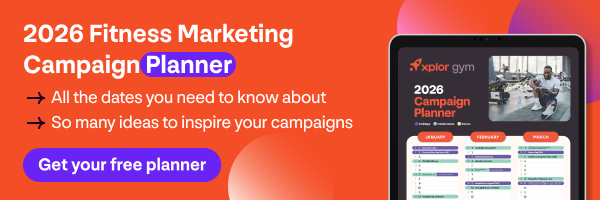Every year brings a fresh calendar of events, public holidays, and awareness days that can spark creative marketing ideas. But the real magic isn’t just in knowing what dates are coming up – it’s in turning them into campaigns that actually convert.
Whether you’re running a small community gym or managing multiple sites, the right campaigns can help you fill classes, boost memberships, and keep members motivated all year long. The trick is planning ahead, staying relevant, and tying your message back to what your audience cares about most – their goals, routines, and lifestyle.
Here’s how to turn those key dates in your 2026 calendar into campaigns that don’t just get likes, but real results.
Step 1: Choose Dates That Make Sense for Your Gym
You don’t need to jump on every trending hashtag or holiday that hits social media. The best campaigns are the ones that genuinely connect with your members and community.
Start by reviewing your 2026 calendar and grouping the dates into categories that make sense for your business. For example:
Health and wellness awareness days:
Think World Health Day (7 April), Mental Health Week (October), or Heart Health Month (February). These are great opportunities to run educational sessions, promote holistic wellness, or highlight how your gym supports overall health – not just fitness.
Seasonal moments:
Summer-ready challenges, winter motivation campaigns, or back-to-school resets are always crowd-pleasers. You might launch a “New Year, Strong Start” program in January, a “Winter Warrior” challenge in July, or an “End of Year Energy” push in November.
Community and cultural events:
Days like International Women’s Day, NAIDOC Week, Matariki, Pride Month, or R U OK? Day can show that your gym values inclusivity and community spirit. Thoughtful, authentic campaigns around these events help strengthen your brand and build trust.
Local or national holidays:
Public holidays and long weekends can also be leveraged. A “Train Before You Travel” pre-holiday workout, or a “Public Holiday Burn” group session, can boost attendance during quieter times.
Once you’ve identified your top dates, pick one or two key events per quarter to focus on. This keeps your calendar manageable and ensures you can put enough energy behind each campaign to make it count.
Step 2: Set a Clear Goal for Each Campaign
Before you design a single post or print a flyer, get clear on what you want the campaign to achieve. Is it:
- To attract new leads?
- Re-engage inactive members?
- Drive attendance for a specific class or program?
- Build your brand presence in the community?
For example:
- Goal: Increase leads in January.
Campaign: “New Year, New Routine” challenge with a free trial week and referral incentive. - Goal: Boost engagement mid-year.
Campaign: “Winter Warrior” streak challenge – complete 20 workouts in 30 days to win prizes. - Goal: Build community awareness.
Campaign: “Move for a Cause” during Mental Health Month, where every class raises a donation.
When your goal is clear, it’s easier to decide on your offer, call to action, and how you’ll measure success.
Strong campaigns start with clear goals.
TipDon’t just ask “what should we post?”… ask “what outcome do we want from this?”
Step 3: Tailor the Message to Your Audience
A good campaign doesn’t just say “we’ve got an offer” – it says “this offer is for YOU.”
Think about the different audiences your gym might have. For example:
- New prospects want motivation to start. Speak to their goals, not the gym features.
“Start strong this year with a fitness routine that sticks.” - Current members want recognition and community. Focus on challenges, rewards, and connection.
“You’ve been putting in the work – now it’s time to show up for the Winter Warrior Challenge.” - Lapsed members might need a nudge to return. Offer an easy way back in.
“We’ve missed you! Come back this month and your first week is on us.”
If your gym serves different demographics (e.g. parents, shift workers, or older adults), you can even tailor the same campaign slightly for each group. The more relevant it feels, the better your results.
Step 4: Build a Compelling Offer or Hook
Your campaign needs a reason for people to take action – something timely, valuable, or exciting enough to get them moving.
Some examples of simple but effective hooks:
- Limited-time offer: “Sign up by 31 January and get your first two weeks free.”
- Challenge or event: “Join our 6-Week Winter Reset Challenge starting 1 June.”
- Giveaway or reward: “Refer a friend during Heart Health Month and go in the draw for a wellness pack.”
- Charity or community angle: “Every class attended during R U OK? Week raises $1 for Lifeline.”
Even if you’re not discounting, you can still make your campaign feel special by framing it around results (“Smash your 2026 goals”), emotion (“Train for your mental health”), or belonging (“Be part of something bigger this month”).
If it doesn’t excite you, it won’t excite them.
TipThe best offers make people feel like they’re part of something meaningful, not just another promotion.
Step 5: Plan Your Campaign Timeline
Good campaigns aren’t built the week before. They’re planned out with enough lead time to build anticipation and engagement.
A simple timeline might look like this:
4–6 weeks before:
- Finalise your concept, offer, and creative.
- Create your assets (landing page, posters, emails, social posts).
- Get your team involved – they’ll be your best advocates.
2–3 weeks before:
- Start teasing it on social media and in your gym.
- Open registrations or pre-sales if relevant.
- Line up supporting content (blogs, videos, member stories).
During the campaign:
- Post daily or weekly updates.
- Share progress, celebrate wins, spotlight members.
- Keep the energy up with reminders and countdowns.
After the campaign:
- Announce winners, share results, and thank participants.
- Capture testimonials or photos for future use.
- Follow up with leads who didn’t convert – they might be ready soon.
A little structure goes a long way. With clear timing and prep, even small campaigns can make a big impact.
Step 6: Mix Up Your Marketing Channels
A strong campaign reaches your audience wherever they are – online, in the gym, or out in the community.
Here’s how to mix it up:
In-gym promotions: Posters, digital screens, and staff talking to members still work wonders. Make sure your team knows what’s happening and can explain it clearly.
Social media: Use short videos, carousels, and stories to build excitement. User-generated content – like members tagging you in their challenge progress – adds authenticity.
Email marketing: Send targeted emails to different groups (members, prospects, lapsed leads). Keep your subject lines catchy and benefit-driven, like “Ready to crush your 2026 fitness goals?”
Landing pages: If you’re running a paid or gated campaign, have a dedicated landing page that explains the offer and includes a clear call to action.
Local partnerships: Partner with nearby cafés, health food stores, or physios for cross-promotion. For example, “Join our Heart Health Month campaign and get 10% off at Green Smoothie Co.”
The more touchpoints you create, the easier it is for people to see, remember, and act on your campaign.
Repetition builds recognition.
TipPeople need to see your message several times before they act – so don’t be shy about showing up everywhere.
Step 7: Track and Measure What Works
The best marketers aren’t just creative – they’re curious.
Tracking helps you understand what campaigns actually drive conversions so you can do more of what works and less of what doesn’t.
Start with a few key metrics:
- New leads generated: How many people signed up for your offer or challenge?
- Membership conversions: How many of those leads joined or upgraded?
- Engagement: Likes, comments, shares, email opens, or attendance numbers.
- Retention: Did participation help keep existing members active or returning more often?
After each campaign, do a quick debrief:
- What worked well?
- What could be improved next time?
- Did we hit our goal?
You can even keep a simple “Campaign Tracker” spreadsheet to record dates, ideas, outcomes, and learnings. Over time, you’ll build a goldmine of insights for future planning.
Step 8: Keep It Authentic
Finally, the most successful campaigns feel real. Fitness marketing has shifted – people want honesty, community, and purpose, not just discounts or before-and-after shots.
So instead of chasing every trend, ask yourself:
- Does this campaign reflect who we are as a gym?
- Is it something our members would genuinely get behind?
- Does it help people feel good about being part of our community?
A well-timed, values-driven campaign builds more than short-term sales – it builds loyalty and word of mouth that lasts all year.
Bonus: Year-Round Inspiration from Your 2026 Planner
Your 2026 Fitness Marketing Campaign Planner is packed with the key dates to spark ideas all year long. Use it as your creative springboard.
Here are a few ways to bring it to life:
- Plan quarterly themes: Align your gym’s focus with the seasons – for example, “New Year Reset,” “Autumn Accountability,” “Winter Wellness,” “Spring Into Summer.”
- Stack awareness days: Combine events that naturally fit together, like World Health Day + Move for a Cause Month.
- Add local flavour: Tie campaigns to your town’s fun runs, school holidays, or charity events to make them more personal.
By using the planner as a starting point and layering on your gym’s unique personality, you’ll always have fresh ideas that drive engagement and growth.

Bringing It All Together
Turning key dates into campaigns that convert isn’t about doing more – it’s about doing it smarter. When you plan ahead, stay authentic, and align your message with what members actually care about, your marketing becomes less of a scramble and more of a strategic advantage.
So grab your 2026 Fitness Marketing Campaign Planner, pick your top dates, and start mapping out the campaigns that will keep your gym buzzing all year long.
Because the best campaigns don’t just fill classes – they build connections, loyalty, and a stronger fitness community.

by Toni Rennie Marketing Director - Xplor Gym ANZ
-
First published: 01 November 2025
Written by: Toni Rennie
